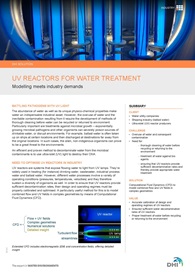Optimising UV reactors for water treatment
At the DHI-NTU Water & Environment Research Centre and Education Hub, we conduct Computational Fluid Dynamics (CFD) modelling of UV reactors for water disinfection. We model and verify designs of reactors provided by our clients.
 At the DHI-NTU Water & Environment Research Centre and Education Hub, we conduct Computational Fluid Dynamics (CFD) modelling of UV reactors for water disinfection. We model and verify designs of reactors provided by our clients. Moreover, we also develop completely new designs of reactors that fulfil prescribed criteria.
At the DHI-NTU Water & Environment Research Centre and Education Hub, we conduct Computational Fluid Dynamics (CFD) modelling of UV reactors for water disinfection. We model and verify designs of reactors provided by our clients. Moreover, we also develop completely new designs of reactors that fulfil prescribed criteria.
UV reactors are systems that expose flowing water to light from UV lamps. They’re widely used in treating drinking water, wastewater, industrial process water, ballast water and so on.
However, different processes involve a variety of operating conditions (pressures, temperatures, velocities) and they therefore sustain a diversity of bio agents as well. In order to ensure that UV reactors provide sufficient decontamination rates, their design and operating regimes must be properly calibrated and optimised. A particularly useful method for this is to model combined flow and UV fields in complex geometries by means of CFD.
Fundamentally, we test whether the amount of survived pathogens in a given UV reactor exceeds a critical value. We thereby help verify that the reactors meet the highest international standards (for instance, the protocols of ballast water treatment) for water quality.
Read more